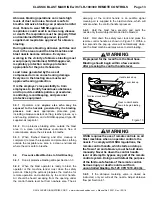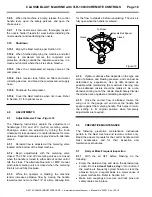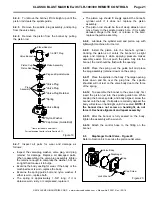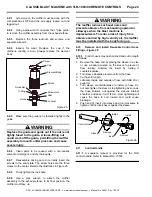
CLASSIC BLAST MACHINE with TLR-100/300 REMOTE CONTROLS
Page 17
© 2018 CLEMCO INDUSTRIES CORP.
www.clemcoindustries.com
Manual No. 22501, Rev. I 02/18
Inspect the RLX control handle; look for the following:
The control handle lever must not seal the opening
on the control unless the safety lever lock is folded
down.
The
handle lever
must return to the UP position
when released.
The
safety lever lock
must return to the UP
position when the handle lever is released.
Both the handle lever and safety lever lock must
move freely with no drag or binding.
WARNING
Malfunctioning control handles can cause
unintentional actuation of a blast machine, or
prevent a machine from deactivating upon
release. Malfunctioning control handles must
be taken out of service immediately and be
repaired or replaced. Serious injury or death
could result from unintentional blasting.
5.1.2
During blasting do the following:
Check the control handle for leaks.
Inspect all couplings and coupling gaskets for leaks.
Check the blast machine for leaks. If leaks are found
around the pop-up valve, inspection door,
pipefittings ports on the side of the machine or at the
bottom of the cone, stop blasting immediately and
repair or replace worn parts.
NOTICE
If leaks are allowed to continue, abrasive
erosion can cause extensive or irreparable
damage to the blast machine.
Check all external piping, control hoses, and valves
for leaks. If leaks are found, stop blasting and repair.
Inspect blast hose, couplings, and nozzle holders for
leaks. At the first sign of a leak, stop blasting and
repair or replace worn parts.
WARNING
Leaks around couplings and nozzle holders
indicate worn or loose-fitting parts. Nozzle
holders and couplings that do not fit tightly on
hose, and nozzles that do not fit tightly in nozzle
holders could disconnect while under pressure.
Impact from objects (nozzles, couplings, hoses,
or abrasive) disconnected by pressure during
operation can cause severe injury.
5.2 Weekly
Inspection
5.2.1
With the air OFF before blasting, do the
following:
Inspect the blast hose for wear; squeeze the hose
every three to four feet and look for soft spots. Soft
spots mean the hose is worn. Replace the blast hose
before the tube wears as far as the fabric plies.
WARNING
Worn blast hose could suddenly burst.
Couplings and nozzle holders may not
adequately grip worn hose, causing them to
blow off under pressure. Compressed air and
abrasive escaping from a burst hose, a
disconnected coupling, or a nozzle holder, can
cause severe injury.
Remove the nozzle for inspection. Replace with a
new nozzle if the orifice diameter is worn 1/16
or
more or if the liner is damaged.
Make sure the nozzle washer is in good condition
and in place before reattaching the nozzle.
WARNING
The threads on the nozzle and nozzle holder
must be inspected each time the nozzle is
secured to the holder. A loose-fitting nozzle
may eject under pressure and cause severe
injury. Check the threads for wear and make
sure the nozzle holder securely holds the
nozzle. The nozzle washer must also be
inspected for wear. When nozzle washers are
worn or missing, abrasive could erode nozzle
threads.
5.2.2
After blasting inspect the following:
Note the time it takes to fully depressurize the machine
after the control handle is released. When
depressurizing time increases noticeably, inspect the
abrasive trap per Section 6.6 and exhaust muffler per
Section 6.9.
















































